Books
A New Book Traces the Visual Symbolism of the Zodiac Throughout Art History—See the Trippy Astrological Images Here
Read an excerpt from the new book 'The Art of the Occult: A Visual Sourcebook for the Modern Mystic.'
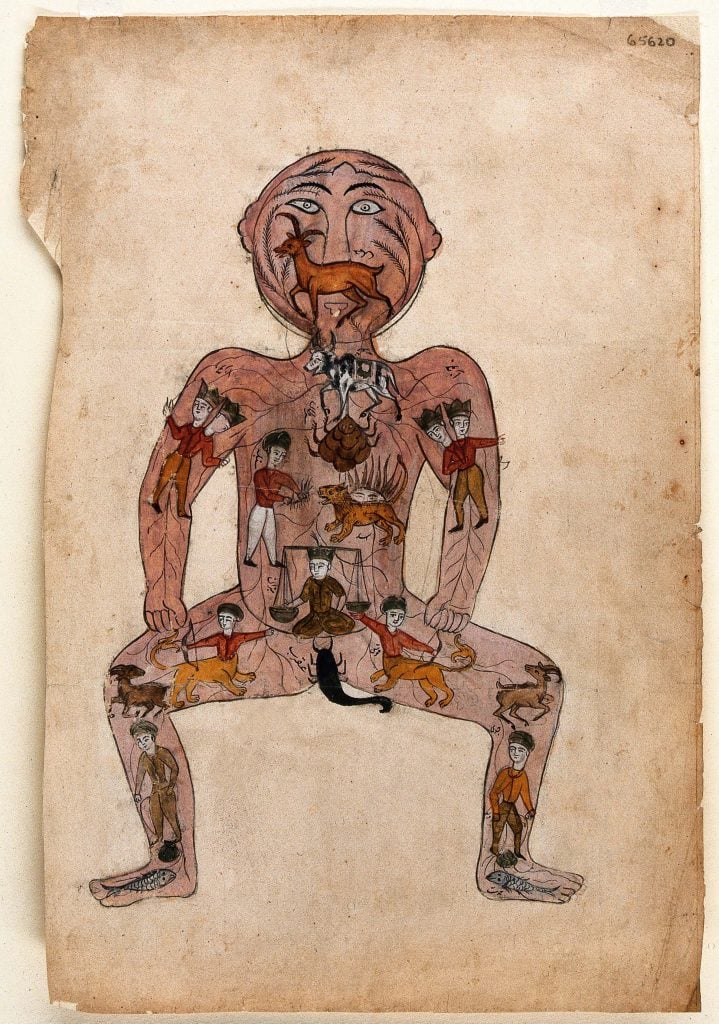
Read an excerpt from the new book 'The Art of the Occult: A Visual Sourcebook for the Modern Mystic.'

S. Elizabeth

Art theorist, intellectual historian, and cultural scientist Aby M. Warburg mused: Was bedeutet es, sich im raum zu orientieren?, a physical and spiritual mouthful which roughly translates as, “What does it mean to orient oneself in space?”
In pondering this question, one may look to Warburg’s wildly ambitious and, sadly, unfinished last project, the Mnemosyne Atlas, a metaphoric mood board comprised of a constellation of symbolic images, created to stimulate the viewer’s memory, imagination, and understanding of what Warburg called “the afterlife of antiquity.” Through these cosmographic and art-historical images (or his “thought space”), Warburg attempts to illuminate how fundamental visual motifs pass from one culture to another over time.
On the subject of space in a more literal sense, Warburg was keenly interested in astrological motifs as pictorial forms that guide and influence humanity in its quest to orientate itself in the cosmos. It was during his speech at the 10th International Congress of Art History held in Rome in 1912 that he shared a critical interpretation of the mysterious frescoes that had been uncovered in the early 19th century in the Palazzo Schifanoia in Ferrara. He saw astrology as representing “an important development on the road to human enlightenment,” and theorized that certain cryptic figures in the frescoes were derived from “decans,” or astrological figures, the gods ruling 10-day periods (the term originates from the division of the signs of the zodiac into three parts of 10 degrees each). Referring to them as “the missing links” between image and symbol, Warburg traced the route of this astrological imagery back through Persian, Indian, Egyptian, and Greek mythology. Scholars declare that this revelation had a “formative influence on our idea of astrology based iconographic symbolism.”
One can hardly blame Warburg for his fascination. Our fierce need to understand the universe and our place in it through the study of the zodiac and practice of astrology permeates our cultural consciousness. And much as they are today, fate and astrology were popular notions with the ancient world as well. For many thousands of years, humans have looked upon the stars as living things, capable of influencing our destinies and bringing a sense of order out of chaos—from predicting weather patterns and natural disasters to guiding the policies of nations and ruling even the smallest daily actions of individuals. Today we mourn the fates of “starcrossed lovers,” we thank our “lucky stars,” we read our horoscopes in the newspapers and say soothing things to our friends after a bad breakup, like, “Well, it makes sense that he was crazy, he was a Scorpio, you know?”
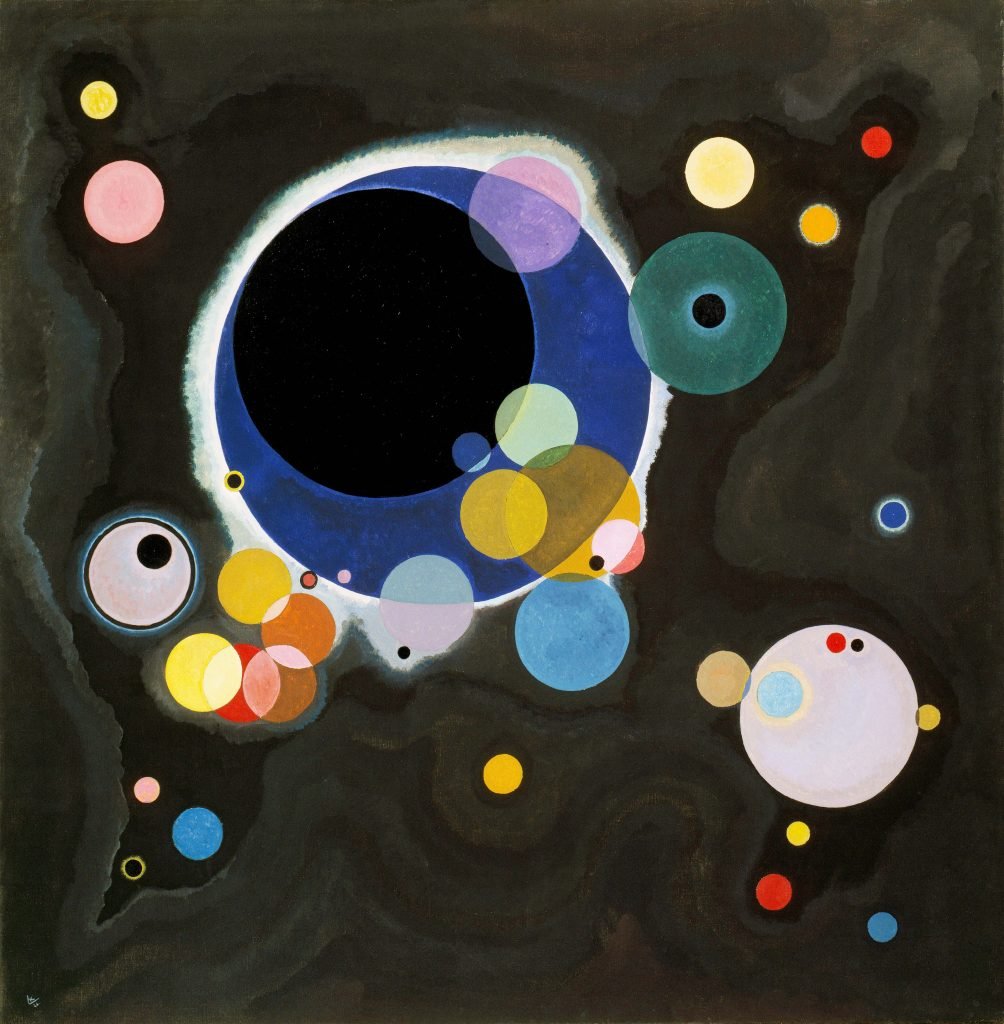
Several Circles, Wassily Kandinsky (1926). While composed as a purely abstract arrangement of various-sized circles, this canvas is full of suggestions of the cosmos and, with imagination, some interesting interpretations of the constellations and the zodiac.
The concept of astrology and the signs of the zodiac did not originate fully formed in the back column of a women’s interest magazine, hard as that might be to believe. The apparent birthplace of astrology was Mesopotamia. For thousands of years before Christ, Assyrians and Babylonians scrutinized the heavens for omens of their fate. Babylonian star lore was introduced to the Greeks early in the fourth century BC and, through the studies and writings of Plato, Aristotle, and others, astrology came to be regarded as an essential science. It was soon adopted by the Romans (the Roman names for the zodiacal signs are still used today) and the Arabs, and eventually spread throughout the entire world.
Of course, as pointed out by Aby Warburg, the symbolism of the stars and the zodiac has long been reflected in various cultures’ illustrations of astrological motifs, in their artful attempts to visually capture the cosmos. Art historians, for example, have spoken on possible astrological interpretations for Leonardo da Vinci’s famous fresco The Last Supper, with each of the 12 apostles representing the 12 signs/constellations of the zodiac and Jesus, the sun; in other interpretations, the astrological energies are rearranged, and Jesus becomes a Pisces. Visionary Surrealist artist Salvador Dalí, with his enthusiastic interest in archetypal imagery and fascination with mysticism and freeing the unconscious from the constraints of everyday reality, depicted the 12 signs of the zodiac in 1967 in a series of watercolors. In a wonderfully absurd example of artistic license (or perhaps paying homage to an earlier, well-known work), he portrayed Cancer the crab as a melancholy polka-dotted lobster.
In examining this centuries-old relationship between astrology and art, we can see some of the fascinating and provocative ways in which astrology, mythology, and symbolism intersect, and gain deeper insight into the question of how art reflects astral and heavenly influences.
See more images from Art of the Occult below.

Zodiac lithograph by Alphonse Mucha (1896).
Alfonse Maria Mucha, known internationally as Alphonse Mucha, was a Czech painter, illustrator, and graphic artist. Living in Paris during the Art Nouveau period, he is best known for his distinctly stylized and decorative theatrical posters. Zodiac was Mucha’s first work under his contract with the printer Champenois, and was originally designed as an in-house calendar for the company. In this piece, Mucha integrated 12 zodiac signs in the halo-like disk behind the woman’s head, one of Mucha’s customary motifs. It became one of his most popular designs.
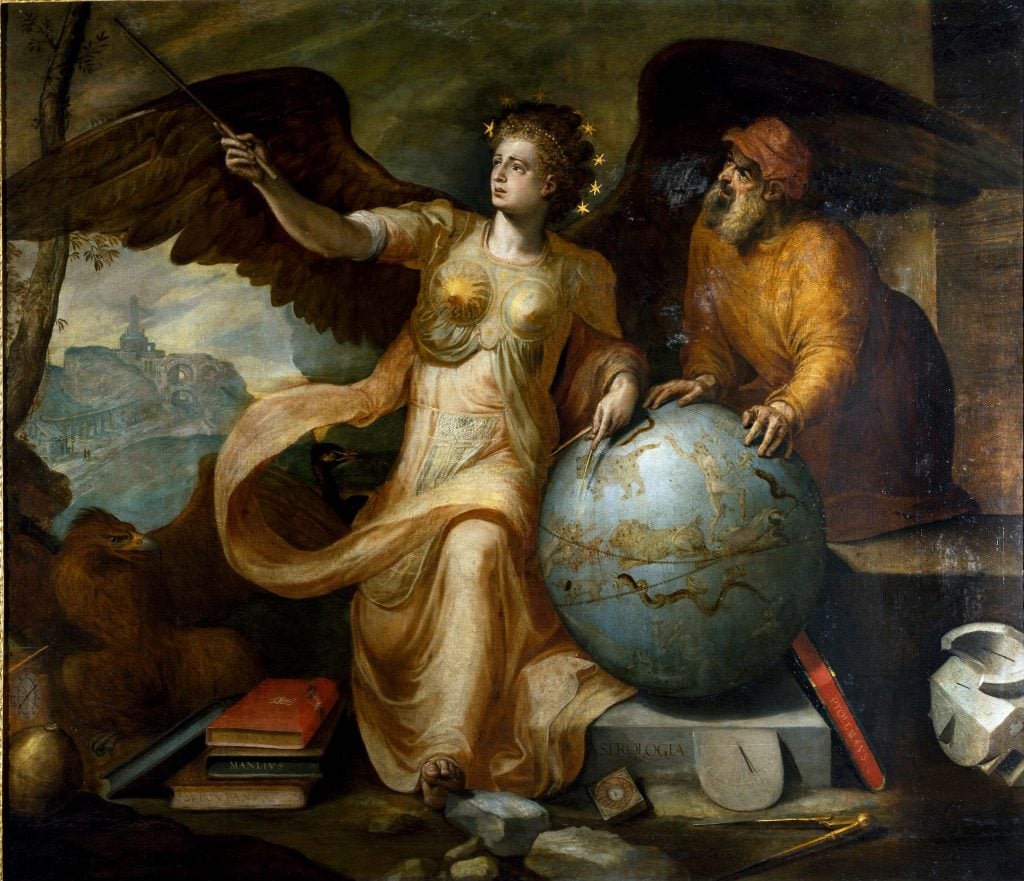
Astrology, Frans Floris, 16th century.
Frans Floris was Flemish painter, draftsman, and etcher who greatly influenced the Northern Renaissance and was well known for portrayals of a broad range of allegorical subject matter. In this painting–exploring the operation of celestial influences on human bodies and terrestrial events–Astrology, a winged female personification, leans besides a globe with zodiacal star symbols. On the ground are various scientific instruments and sundials. This is one among a series of paintings by Floris for the villa of merchant and art-collector Nicolaas Jongelinck.
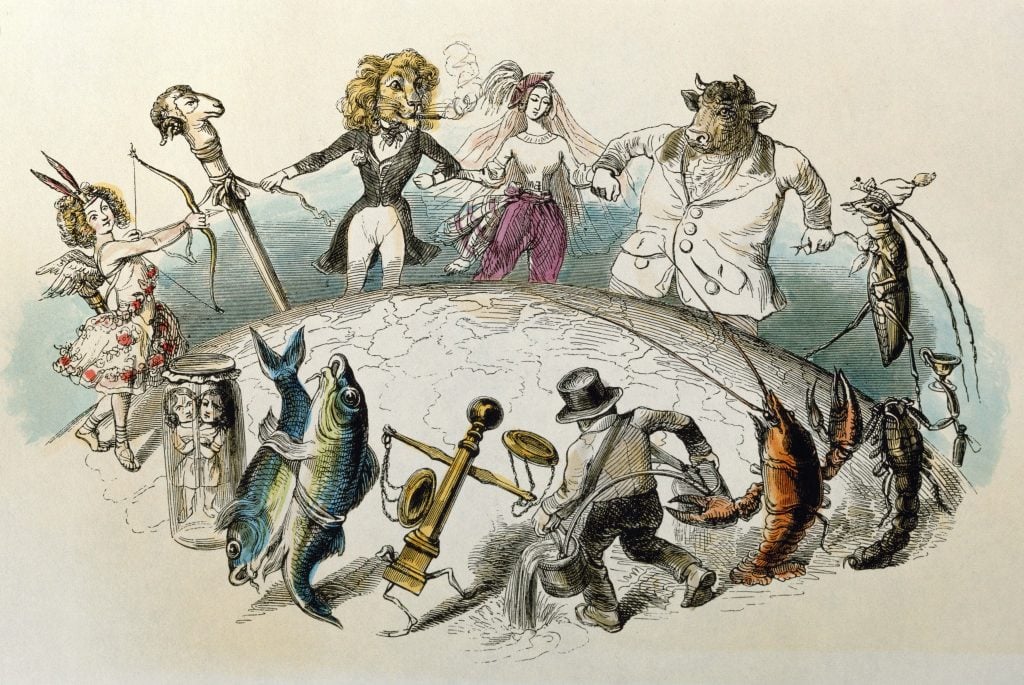
The zodiac in a round dance around the world by JJ Grandville (1847).
Influential and prolific French illustrator and caricaturist J. J. Grandville created delightful, discordant and anthropomorphized imagery which “captured the foibles and follies of humanity with the metaphor of the menagerie.” Grandville’s work is now recognized as a major precursor and inspiration to the Surrealist movement. In this dancing circle of astrological archetypes, we can make out the attributes of each of the signs of the zodiac. As for the artist himself, born on September 13, 1803—Grandville was a Virgo.

Patrizia La Porta, Michel de Nostradamus, Astrologer.
Contemporary illustrator Patrizia La Porta’s colorful rendering of Nostradamus (also called Michel de Nostredame) depicts the French astrologer, physician, and most widely renowned seer of the Renaissance, flitting whimsically throughout the night sky, ostensibly consulting the stars and engaging in prophetic mediations.
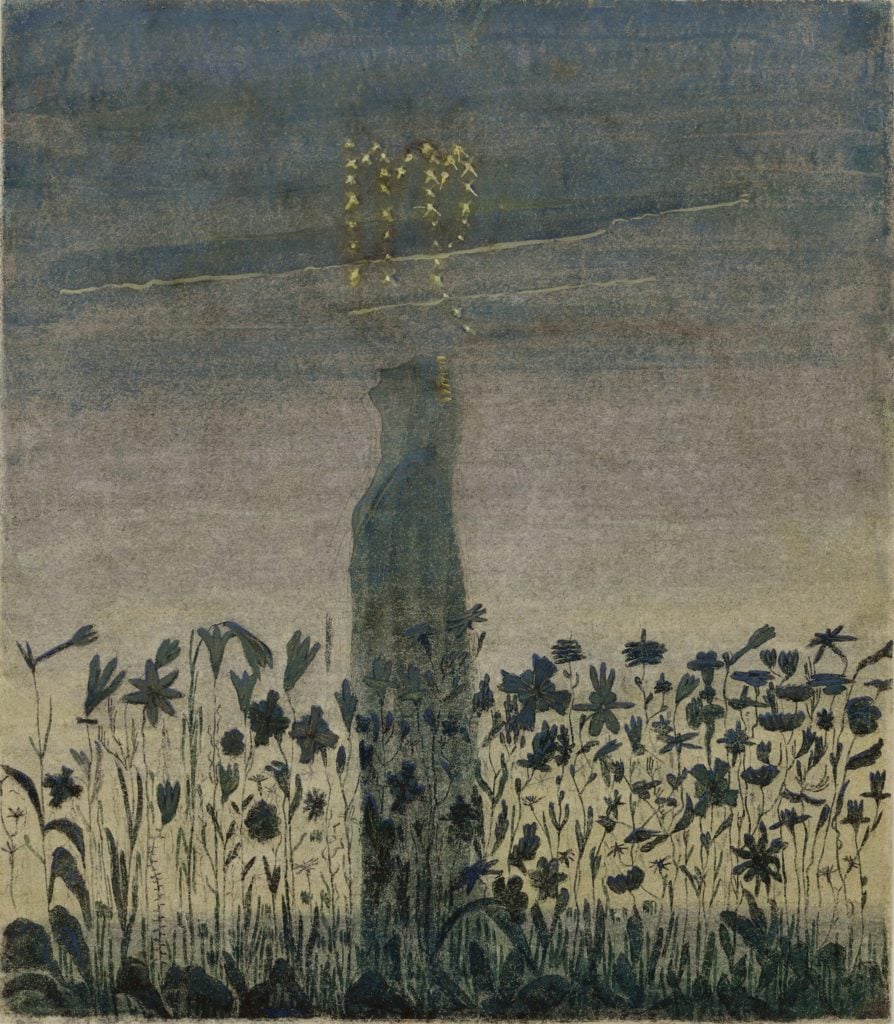
M. K. Cˇiurlionis, The Sun is Passing the Sign of Virgo (1906/7) from “The Zodiac.”
Mikalojus Konstantinas Cˇiurlionis was a Lithuanian painter, composer, and writer and has been considered one of the pioneers of abstract art in Europe. Cˇiurlionis was interested in the structure of the universe and man’s place in it. The most famous of Cˇiurlionis’s series is his 12 paintings named “The Zodiac.” This theme was inspired by the ancient myths of the constellations and it was supported by the artist’s interest in astronomy.
S. Elizabeth (aka Mlle Ghoul) is a Florida-based writer specializing in art, the macabre, and the supernatural. She is a staff writer at Haute Macabre and has written for Coilhouse, Dirge, and the blog Death & the Maiden. S. Elizabeth was also the co-creator of The Occult Activity Book (vol 1 and 2) and runs two successful blogs: Ghoul Next Door (ghoulnextdoor.tumblr.com) and These Unquiet Things (unquietthings.com).
Excerpted from The Art of the Occult S. Elizabeth, © 2020. Used with permission from White Lion Publishing, an imprint of Quarto Publishing Group.